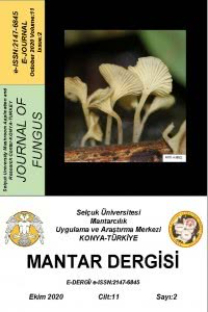Fomes fomentarius‘dan elde edilen çeşitli formülasyonların hastane izolatlarına karşı antimikrobiyal etkisi
Bu çalışmanın amacı, F. fomentarius formülasyonlarının antimikrobiyal aktivitesini araştırmaktır. Etanol ve sudan hazırlanan F. fomentarius özütlerinin ve çeşitli formülasyonların (emülsiyon, merhem, pat, krem ve jel) antimikrobiyal etkinlik seviyeleri belirlendi. Bu amaçla ekstreleri, Klebsiella pneumoniae, Acinetobacter baumannii, Staphylococcus aureus, vankomisine dirençli enterokok, (VRE +), Escherichia coli, Candida krusei; C. albicans, C. tropicalis, C. guilliermondii ve C. glabrata içeren hastane izolatlarına karşı antimikrobiyal aktivite açısından test etmek için disk difüzyon yöntemi kullanılmıştır. Karşılaştırma için bazı standart antibiyotikler kullanılmıştır. Merhem formülasyonu (No. 4), antibiyotiklere kıyasla bakteriler üzerinde iyi bir antimikrobiyal etki göstermiştir (9.6 - 16.1 mm.). Ekstrelerin Candida türlerine karşı antibiyotiklerden daha etkili olduğu bulunmuştur. 4 Nolu formülasyonun, setil alkolünün ve sodyum lauril sülfat (SLS) içeriğinin koruyucu doğası nedeniyle daha etkili olduğu düşünülmüştür. F. fomentarius etanol ekstresi, F. fomentarius su ekstresi ve jel formülasyonu benzer aktivite göstermiştir; bununla birlikte, diğer formülasyonlar (emülsiyon, pat, krem), preparasyonlarında bulunan polimerlerin, yağın ve alkollerin stabilize edici etkileri nedeniyle genellikle daha etkili olmuştur. Bu çalışmanın bulguları, klinik olarak etkili yeni antibiyotik ilaçları keşfetme olasılığını ortaya koymaktadır ve geleneksel ilaçlar ile modern ilaçlar arasındaki ilişkiyi anlamada faydalı olabilir.
Anahtar Kelimeler:
Fomes fomentarius, β-glukan, antimikrobiyal aktivite, sodyum lauril eter sülfat, setil alkol
The antimicrobial effect of various formulations obtained from Fomes fomentarius against hospital isolates
The purpose of this study was to investigate the antimicrobial activity of formulations of F. fomentarius. The antimicrobial efficacy levels of extracts of F. fomentarius prepared from ethanol, water and of various formulations (emulsion, ointment, paste, cream and gel) were determined. For this purpose, the disk diffusion method was used to test the extracts for antimicrobial activity against hospital isolates including Klebsiella pneumoniae, Acinetobacter baumannii, Staphylococcus aureus, vancomycin-resistant enterococci (VRE+), Escherichia coli, Candida krusei, C. albicans, C. tropicalis, C. guilliermondii and C. glabrata. Some standard antibiotics were used for comparison. The ointment formulation (No. 4) showed a good antimicrobial effect on bacteria compared to the antibiotics (9.6 - 16.1 mm.). The extracts were found to be more effective than the antibiotics against Candida species. Formulation No. 4 was considered to be more effective because of the protective nature of its cetyl alcohol and sodium lauryl sulfate (SLS) content. F. fomentarius ethanol extract, F. fomentarius water extract and gel formulation showed similar activity; however, other formulations (emulsion, paste, cream) were generally more effective due to the stabilizing effects of the polymers, oil and alcohols present in their preparations. The findings of this study establish the possibility of discovering new clinically effective antibiotic drugs and could be useful in understanding the relationship between traditional remedies and modern medicines.
Keywords:
Fomes fomentarius, β-glukan, antimicrobial activity, sodium lauryl ether sulphate, cethyl alchol,
___
- Akramiene D, Kondrotas A, Didziapetriene J, Kevelaitis E. (2007).Effects of beta-glucans on the immune system. Medicina.,43 (8) 597–606.
- Breitenbach J, Kränzlin F. Fungi of Switzerland Vol 2 (1986). Non gilled fungi. Switzerland: Verlag Mykologia, 1-412.
- Clinical and Laboratory Standards Institute / NCCLS Performance standards for antimicrobial disk diffusion tests; Approved standards 9th ed. CLSI Document M2-M9.
- Committee for Human Medicinal Products (CHMP). Background review for sodium lauryl sulfate used as an excipient 2015 EMA/CHMP/351898/2014.http://www.ema.europa.eu/docs/en_GB/document_library/Report/2015/08/WC500191475.pdf (Accessed: 16.04.2018 ).
- Gao HL, Lei LS, Yu CL, Zhu ZG, Chen NN, Wu SG.(2009). Immunomodulatory effects of Fomes fomentarius polysaccharides: An experimental study in mice. Nan fang yi ke da xue xue bao. J South Med Univ., 29 (3) 458–461.
- Grienke U, Zöll M, Peintner U, Rollinger JM.(2014). European medicinal polypores–A modern view on traditional uses. J Ethnopharmacol., 154 (3) 564–583.
- Heleno SA, Martins A, Queiroz MJR, Ferreira IC.(2015). Bioactivity of phenolic acids: Metabolites versus parent compounds: A review. Food Chem., 173, 501–513.
- Kolundžić M, Grozdanić ND, Dodevska M, Milenković M, Sisto F, Miani A, Farronato G, Kundaković T.(2016). Antibacterial and cytotoxic activities of wild mushroom Fomes fomentarius (L.) Fr., Polyporaceae. Ind Crops Prod., 79, 110–115.
- Onderdonk AB, Cisneros RL, Hinkson P, Ostroff G. (1992). Anti-infective effect of poly-beta 1-6-glucotriosyl-beta 1-3-glucopyranose glucan in vivo: Infect Immun., 60, 1642–1647.
- Senyuk OF, Gorovoj LF, Beketova GV, Savichuk NO, Rytik PG, Kucherov I, Prilutsky A I.(2011). Anti-infective properties of the melanin-glucan complex obtained from medicinal tinder bracket mushroom, Fomes fomentarius (L.: Fr.) Fr.(Aphyllophoromycetideae). Int J Med Mushrooms., 13 (1) 7–18.
- Shin MS, Lee S, Lee KY, Lee HG.(2005). Structural and biological characterization of aminated-derivatized oat β-glucan. J Agric Food Chem.,53, 5548–5554.
- Tadamichi T, Kyoko I, Eiichi S.(1981). Effects of sodium lauryl sulfate on glucan synthesis by glucosyltransferases of Streptococcus mutans OMZ 176. Jpn J Oral Biol.,23(4) 809–816.
- Vetrovsky T, Vorísková J, Snajdr J, Gabriel J, Baldrian P. (2011). Ecology of coarse wood decomposition by the saprotrophic fungus Fomes fomentarius. Biodegradation. 22 (4) 709–718.
- Vetvicka V, Terayama K, Mandeville R, Brousseau P, Kournikakis B, Ostroff G.(2002). Pilot Study: Orally-Administered Yeast β-1,3-glucan Prophylactically Protects Against Anthrax Infection and Cancer in Mice. J Am Nutr Assoc.,5: 5–9.
- Wei CB, Zhao Z, Yongquan L.(2011). Simultaneous increase of mycelial biomass and intracellular polysaccharide from Fomes fomentarius and its biological function of gastric cancer intervention. Carbohyd Polym.,85, 369–375.
- Zhao JY, Ding JH, Li ZH, Dong ZJ, Feng T, Zhang HB, Liu JK.(2013). Three new phenyl-ethanediols from the fruiting bodies of the mushroom Fomes fomentarius. J Asian Nat Prod Res., 15(3) 310–314.
- ISSN: 2147-6845
- Yayın Aralığı: Yılda 2 Sayı
- Başlangıç: 2010
- Yayıncı: Selçuk Üniversitesi Mantarcılık Uygulama ve Araştırma Merkezi Müdürlüğü
Sayıdaki Diğer Makaleler
Psathyrella typhae, Türkiye için yeni bir makromantar kaydı
Raziye İLERİ, Yasin UZUN, ABDULLAH KAYA
Gautieria graveolens’in Türkiye’de Yeniden Keşfi
Yasin UZUN, Semiha YAKAR, ABDULLAH KAYA
Banu COŞKUN AKÇAY, HASAN HÜSEYİN DOĞAN
Bitki Patojeni Fungusların Evrimini Etkileyen Bazı Faktörler
Kastamonu ve Erzincan İllerindeki Tereyağlardan İzole Edilen Funguslar Üzerine Araştırmalar
Hikmet Öznur ÖZTÜRK, Günay Tülay ÇOLAKOĞLU
Farklı Mantar Türleri Kullanılarak Sentetik Atıksudan Adsorpsiyon Prosesi ile Boya Giderimi
MUHAMMED KAMİL ÖDEN, Sinan ALKAN, GIYASETTİN KAŞIK
Helvella phlebophora, Türkiye İçin Yeni Bir Askomiset Kaydı
Aladağlar ve Bolkar Dağları (Türkiye)’ndan Belirlenen Sürme Mantarları
